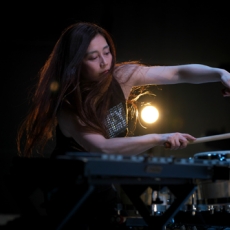KUNIKO - J.S. Bach: Solo Works for Marimba - Audiophile Audition
On the phylogenetic tree of musical instruments, in terms of sound production, the ancient marimba would be a low branch. Its massive limb juts out with no further developments, fundamental, but non-dynamic in its organizing principles. Its evolutionary equivalent in biology might be the turtle, changeless and serene in its formal perfection. While the dinosaurs demonstrated a baroque inventiveness in the areas of feather and beak with spectacular results, the turtle didn’t wish to press its luck, preferring to stay inside its shell, the very symbol of conservatism. So it has been with the marimba: it remains a piece of wood perched on a sounding device, hit with a stick. (The evolutionary relationship of the marimba to the vibraphone is a matter of debate.)
A hypothetical scenario of its origins comes readily to mind. By chance, a man hits a hollow log with a stick and then the larger log alongside with the stick in his other hand. Insight dawns as he arrives at the essential relation of sound production to geometry. It is only a matter of time until woman, the eternal improver, places her hollow gourd or turtle shells under the now tone-selected pieces of wood; and with that, a new sound wafts out into the African night, startling and beautiful.
From its place of origin in Zimbabwe, the marimba made the transatlantic journey with the African diaspora, arriving in Central America where the first diatonic marimba, still equipped with the gourd resonators, was documented by Domingo Juarraz in 1680. Its subsequent evolution concerns itself with the expansion of the range of the instrument and the amplification of the sound through modifications of the resonator apparatus. Today’s marimbas range up to five octaves and have replaced the gourds with aluminum and more recently even PVC tubing.
The performance at hand is not the first time Bach has been recorded on the marimba. It’s also not uncommon to hear a street musician toss off one of Bach’s little preludes and fugues or a two-part invention on such a mallet instrument. The effect is typically a kind of cheerful novelty act: dancing, Caribbean, rum at sunset conviviality. Kuniko, a Japanese virtuoso, aims at going well beyond this standard with a profound rendering of the serious repertoire for solo violin and cello as well as two preludes from the Well-Tempered Clavier. Perhaps her only concession to familiarity and amateur accessibility is the (overly) well-known Suite No.1 in G major.
Kuniko asserts the radical notion of the marimba as sui generis sound which stands adjacent and not inferior to any other form of plucking, bowing, or wind. Indeed, her performance yields an entirely original presentation of both the instrument and Bach’s genius.
Throughout, she focuses the deeply resonant sound of her instrument (about which no details are available in the fluffy liner notes) on the contrapuntal and melodic power of this music. She opts not to make these dance suites dance; the minuet and the gigue and fleet courante are all played with measured contemplation. Kuniko avoids lethargy and somnambulism by means of her exquisite rhythmic finesse. No lines are ever blurred, and the subtlest use of rubato gives the most pleasing shape to phrase, evoking sway and movement at every turn.
The transcription is modest in terms of fleshing out the implied harmonies, especially compared with lute and guitar versions of these works. Yet one wouldn’t want any added notes. It cannot be overstated how big this sound is. It fills the room and vibrates bones and internal organs. On Prelude of Cello Suite No. 5 she layers this sound while navigating the two voices with an implied third line, casting a mesmerizing seven-minute spell. Another feature worth noting is her use of ornamentation, idiomatic to mallet techniques and full of surprises. The fifth suite is a big work, and not the one that you can encounter daily on the High-Line in NYC or in front of Starbucks in your average college town, as you might the first two “easy” suites. You will never hear it played quite like this, with the combination of resonant wood and introspection that is Kuniko’s own patent.
The second disc opens with the C minor prelude from the WTC. Made famous by guitarists, it makes far more sense for this instrument. Why she omits the fugue is a puzzle. We don’t have to wait long, however, for the first of three great fugues. Each of the violin works has a second movement fugue. More than anything else, these are the pieces that separate Kuniko from her rivals–and not only mallet players, for it is not easy to hold these polyphonic movements together on a solo instrument. It helps that she has four mallets, but the key is in the concentration, all the more important as she takes the pieces extraordinarily slowly. (the Fuga of BWV 1003 is 9:56 compared to Oscar Shumsky at 7:45).
The Sonatas BWV 1001 and 1002 are both in minor keys, which adds to the brooding introspection. Every so often in the upper end of the instrument, the rapid quavers of the mallet conjure up the organ at its most rarified. On the Andante of the A minor work, the quavers float like steel pans. We are very far away from the violin and the acidulous double-stops which are inescapable in the famously difficult sei solo.
If I had to choose one instrument to realize the magnificent Violin Sonata No. 3 in C major, it would be the lute. (Consider the memorable recordings by Hopkinson Smith and Nigel North, the latter on this same label.) But the marimba would be my second choice, well ahead of the violin.
The final demonstration of Kuniko’s art, as well as the Kapellmeister’s deep science, unfolds in the 12-minute fuga of BWV 1005. Never has the ponderous harmonic tension been borne aloft so easily; it is a summation and the final ascension of these grand works. The final Allegro assai has the marimba racing along, all four mallets warbling up a terrific chorus of semi-quavers. For sonics, this would be my demonstration piece, the full range of the instrument on marvelous display–along with the technical prowess of this gifted artist.
To add one more bit of context to an already improbable circumstance of this recording, we should mention that it was recorded in the 13th-century Jaani Kirik, (St. John’s Church) in Tartu, Estonia. That is a long way from Japan, but Ms. Kuniko explains that she “likes the air and the feel.” Who are we to argue? The air and feel of this recording are something extraordinary.

